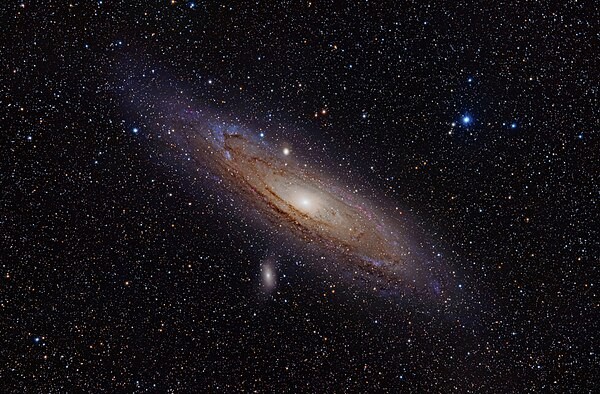The size of the Milky Way galaxy compared to others is a captivating topic that underscores the vastness of the universe, explored in depth at COMPARE.EDU.VN. Understanding the scale of our galaxy, the Milky Way, in relation to other galaxies provides a crucial perspective on our place in the cosmos, prompting intriguing questions about galactic dimensions and astronomical comparisons. Discover cosmic proportions and galaxy size comparison, enhancing your understanding of our galactic neighborhood.
1. Grasping the Concept of a Galaxy
Galaxies are fundamental building blocks of the universe, serving as immense collections of stars, gas, dust, and dark matter, all held together by gravity. Understanding their basic structure and components is essential before comparing their sizes.
1.1. The Basic Definition
A galaxy is a gravitationally bound system consisting of stars, stellar remnants, interstellar gas, dust, and dark matter. These components orbit a common center of mass. Galaxies range in size from dwarfs containing as few as a few million stars to giants boasting trillions.
1.2. Types of Galaxies
Galaxies come in various types, each with distinct characteristics:
- Spiral Galaxies: Characterized by a central bulge surrounded by a flat, rotating disk of stars, gas, and dust, with spiral arms extending outward. The Milky Way is a spiral galaxy.
- Elliptical Galaxies: These galaxies have an ellipsoidal shape and consist mainly of older stars with little gas and dust. They range in size from dwarf ellipticals to giant ellipticals.
- Irregular Galaxies: Galaxies that do not have a distinct shape. They often result from galactic collisions or gravitational interactions.
- Lenticular Galaxies: Intermediate between spiral and elliptical galaxies, featuring a disk but lacking prominent spiral arms.
1.3. Components of a Galaxy
Typical components include:
- Stars: The primary luminous objects in a galaxy, generating light and heat through nuclear fusion.
- Interstellar Medium (ISM): Gas and dust that fill the space between stars. It is the raw material for new star formation.
- Dark Matter: A mysterious, non-luminous substance that makes up a significant portion of a galaxy’s mass. Its gravitational effects influence galactic rotation and structure.
- Supermassive Black Hole (SMBH): Found at the center of most large galaxies, an SMBH has a mass millions or billions of times that of the Sun.
2. The Milky Way: Our Galactic Home
Understanding the Milky Way’s characteristics is crucial for comparison. We’ll delve into its structure, size, and unique features.
2.1. Structure of the Milky Way
The Milky Way is a barred spiral galaxy, meaning it has a central bar-shaped structure.
- Central Bulge: A dense concentration of stars and gas at the galaxy’s center, housing a supermassive black hole known as Sagittarius A*.
- Galactic Disk: A flat, rotating structure containing the majority of the galaxy’s stars, gas, and dust. The spiral arms are located within the disk.
- Spiral Arms: Regions of higher density where star formation is active. The Milky Way has several major spiral arms, including the Perseus Arm and the Scutum-Centaurus Arm.
- Galactic Halo: A diffuse, spherical region surrounding the disk, containing globular clusters, old stars, and dark matter.
2.2. Size and Dimensions
The Milky Way spans approximately 100,000 to 180,000 light-years in diameter. Its thickness varies, with the disk being relatively thin, around 1,000 light-years thick.
2.3. Unique Features of the Milky Way
- *Sagittarius A:** The supermassive black hole at the galactic center, with a mass about 4 million times that of the Sun.
- The Local Group: The Milky Way is part of the Local Group, a cluster of galaxies that includes Andromeda and Triangulum galaxies, along with numerous dwarf galaxies.
- Ongoing Galactic Mergers: The Milky Way is currently in the process of merging with several dwarf galaxies, such as the Sagittarius Dwarf Spheroidal Galaxy.
3. How We Measure Galactic Sizes
Determining the size of galaxies involves various techniques, each with its own advantages and limitations.
3.1. Measuring Distances in Space
Accurate distance measurements are essential for determining the true size of galaxies. Common methods include:
- Parallax: Measuring the apparent shift in a star’s position as Earth orbits the Sun. This method is accurate for nearby stars.
- Standard Candles: Using objects with known luminosity, such as Cepheid variable stars and Type Ia supernovae, to estimate distances.
- Redshift: Measuring the stretching of light from distant galaxies due to the expansion of the universe. Redshift is proportional to distance, but it requires calibration using other distance indicators.
3.2. Determining Diameter and Mass
Once distances are known, astronomers can determine galactic diameters and masses.
- Diameter: Measuring the angular size of a galaxy in the sky and using its distance to calculate the physical diameter.
- Mass: Estimating the total mass of a galaxy by measuring the rotational speeds of stars and gas within it. This method relies on the principles of gravity and orbital mechanics.
3.3. Challenges in Measurement
Measuring galactic sizes is challenging due to several factors:
- Dust Obscuration: Interstellar dust can obscure light from distant galaxies, making it difficult to accurately measure their size and brightness.
- Defining the Edge: It can be challenging to define the exact edge of a galaxy, as the density of stars and gas gradually decreases with distance from the center.
- Dark Matter: The presence of dark matter, which does not interact with light, makes it difficult to accurately determine the total mass of a galaxy.
4. Notable Galaxies and Their Sizes
To put the Milky Way’s size into perspective, let’s compare it to several other notable galaxies.
4.1. Andromeda Galaxy (M31)
The Andromeda Galaxy is the Milky Way’s largest neighbor and a dominant member of the Local Group.
- Size: Approximately 220,000 light-years in diameter.
- Mass: Estimated to be roughly equal to or slightly larger than the Milky Way’s mass.
- Distance: About 2.5 million light-years from Earth.
- Interesting Facts: Andromeda is approaching the Milky Way at a speed of about 110 kilometers per second, and the two galaxies are predicted to collide in about 4.5 billion years.
 Andromeda Galaxy
Andromeda Galaxy
4.2. Triangulum Galaxy (M33)
A smaller spiral galaxy in the Local Group.
- Size: About 50,000 to 60,000 light-years in diameter.
- Mass: Significantly less massive than the Milky Way and Andromeda.
- Distance: Approximately 3 million light-years from Earth.
- Interesting Facts: Triangulum is believed to be gravitationally bound to Andromeda and may eventually merge with it.
4.3. Large Magellanic Cloud (LMC)
A dwarf irregular galaxy orbiting the Milky Way.
- Size: Roughly 14,000 light-years in diameter.
- Mass: Much smaller than the Milky Way.
- Distance: About 160,000 light-years from Earth.
- Interesting Facts: The LMC is home to the Tarantula Nebula, one of the largest and most active star-forming regions known in the Local Group.
4.4. Small Magellanic Cloud (SMC)
Another dwarf irregular galaxy orbiting the Milky Way.
- Size: About 7,000 light-years in diameter.
- Mass: Smaller than the LMC.
- Distance: Approximately 200,000 light-years from Earth.
- Interesting Facts: The SMC has a highly disturbed structure, likely due to gravitational interactions with the Milky Way and LMC.
4.5. IC 1101
One of the largest known galaxies in the observable universe.
- Size: Estimated to be around 4 million light-years in diameter.
- Mass: Enormously massive, containing trillions of stars.
- Distance: Over 1 billion light-years from Earth.
- Interesting Facts: IC 1101 is an elliptical galaxy located in the Abell 2029 galaxy cluster. Its immense size is believed to be the result of numerous galactic mergers.
5. Comparing the Milky Way to Other Galaxies
Now, let’s directly compare the Milky Way to these other galaxies to gain a better perspective on its size and characteristics.
5.1. Size Comparison
| Galaxy | Diameter (light-years) | Relative Size (Compared to Milky Way) |
|---|---|---|
| Milky Way | 100,000 – 180,000 | 1x |
| Andromeda (M31) | 220,000 | 1.2 – 2.2x |
| Triangulum (M33) | 50,000 – 60,000 | 0.3 – 0.6x |
| Large Magellanic Cloud | 14,000 | 0.08 – 0.14x |
| Small Magellanic Cloud | 7,000 | 0.04 – 0.07x |
| IC 1101 | 4,000,000 | 22.2 – 40x |
This table illustrates that the Milky Way is a relatively large galaxy compared to its Local Group neighbors like Triangulum, the LMC, and the SMC. However, it is significantly smaller than giant galaxies like IC 1101.
5.2. Mass Comparison
Estimating galactic mass is more complex than measuring diameter, but here’s a rough comparison:
- Milky Way: Estimated mass of 1 to 1.5 trillion times the mass of the Sun.
- Andromeda: Mass estimates vary, but generally considered similar to or slightly greater than the Milky Way.
- Triangulum: Much less massive than the Milky Way, likely around 50 billion times the mass of the Sun.
- LMC and SMC: Significantly less massive, each containing only a small fraction of the Milky Way’s mass.
- IC 1101: One of the most massive galaxies known, likely containing tens of trillions of times the mass of the Sun.
5.3. Brightness and Luminosity
A galaxy’s brightness is related to the number and type of stars it contains, as well as the rate of star formation.
- Milky Way and Andromeda: Both are bright, active galaxies with ongoing star formation.
- Triangulum: Less luminous than the Milky Way and Andromeda due to its smaller size and lower star formation rate.
- LMC and SMC: Much fainter than the Milky Way due to their smaller size and lower stellar populations.
- IC 1101: Extremely luminous due to its enormous size and vast number of stars.
5.4. Galactic Environment
The environment in which a galaxy resides can significantly impact its evolution.
- Milky Way: Located in the Local Group, which is relatively sparse compared to denser galaxy clusters.
- Andromeda: Also a dominant member of the Local Group.
- Triangulum: Interacting with Andromeda, which may influence its star formation and structure.
- LMC and SMC: Orbiting the Milky Way, and their interactions with our galaxy have likely shaped their irregular forms.
- IC 1101: Resides in the center of the Abell 2029 galaxy cluster, a dense environment where galactic mergers are common.
6. The Significance of Galactic Size Differences
Why do galaxies vary so much in size? The differences stem from a combination of factors related to their formation and evolution.
6.1. Formation and Evolution
- Initial Conditions: The initial density fluctuations in the early universe played a crucial role in determining the size and mass of galaxies. Regions with higher density attracted more matter and grew into larger galaxies.
- Mergers: Galactic mergers are a significant factor in galaxy evolution. When galaxies collide and merge, their stars, gas, and dark matter combine to form a larger galaxy. IC 1101, for example, likely grew to its immense size through numerous mergers.
- Gas Accretion: Galaxies can grow by accreting gas from the intergalactic medium. This gas fuels star formation, increasing the galaxy’s stellar population and size.
- Star Formation Rate: The rate at which a galaxy forms new stars influences its luminosity and chemical composition. Galaxies with high star formation rates tend to be brighter and bluer.
6.2. Environmental Influences
- Density of the Environment: Galaxies in dense environments, such as galaxy clusters, experience more frequent interactions and mergers, which can lead to the formation of giant elliptical galaxies.
- Tidal Interactions: Gravitational interactions between galaxies can strip away gas and stars, altering their shape and size. The Milky Way’s interactions with the LMC and SMC have likely influenced their structures.
- Ram Pressure Stripping: In galaxy clusters, the hot intracluster medium can strip gas from galaxies as they move through it, suppressing star formation and potentially leading to the formation of lenticular galaxies.
6.3. Dark Matter’s Role
Dark matter plays a crucial role in galaxy formation and evolution.
- Halo Formation: Dark matter halos provide the gravitational scaffolding for galaxies to form. The size and mass of a dark matter halo influence the size and mass of the galaxy that forms within it.
- Stabilizing Disks: Dark matter helps stabilize galactic disks, preventing them from collapsing or breaking apart.
- Influencing Rotation: The distribution of dark matter affects the rotation curves of galaxies, providing evidence for its existence and influence.
7. Implications for Our Understanding of the Universe
Studying the sizes and characteristics of galaxies has profound implications for our understanding of the universe.
7.1. Galaxy Formation Theories
Comparing the properties of different galaxies helps refine theories of galaxy formation and evolution.
- Hierarchical Clustering: The prevailing theory suggests that galaxies form through a process of hierarchical clustering, where smaller structures merge to form larger ones. Observations of galaxies at different redshifts provide evidence for this process.
- Simulations: Computer simulations play a crucial role in testing and refining galaxy formation theories. These simulations model the formation of galaxies from initial density fluctuations in the early universe.
7.2. Cosmological Models
The distribution and properties of galaxies provide constraints on cosmological models.
- Dark Energy: The expansion rate of the universe, driven by dark energy, influences the growth of structures like galaxies. By studying the distribution of galaxies, astronomers can constrain the properties of dark energy.
- Dark Matter: The abundance and distribution of dark matter influence the formation and evolution of galaxies. Observations of galaxies and galaxy clusters provide evidence for the existence and properties of dark matter.
7.3. The Search for Life
Understanding the characteristics of galaxies can inform the search for life beyond Earth.
- Habitable Zones: The size and type of a galaxy can influence the habitability of planets within it. For example, galaxies with high rates of supernovae may be less hospitable to life due to the increased risk of radiation exposure.
- Galactic Distribution of Elements: The distribution of heavy elements in a galaxy can influence the formation of rocky planets and the potential for life to evolve.
8. Future Research and Discoveries
The study of galactic sizes and characteristics is an ongoing field of research with many exciting avenues for future exploration.
8.1. Next-Generation Telescopes
New telescopes, such as the James Webb Space Telescope (JWST) and the Extremely Large Telescope (ELT), will provide unprecedented views of galaxies at high resolution and sensitivity.
- JWST: Will allow astronomers to study the earliest galaxies in the universe, providing insights into their formation and evolution.
- ELT: Will provide extremely detailed images of galaxies, allowing astronomers to study their structure and dynamics with unprecedented precision.
8.2. Surveys and Mapping
Large-scale surveys, such as the Sloan Digital Sky Survey (SDSS) and the Dark Energy Survey (DES), are mapping the distribution of galaxies in the universe.
- SDSS: Has mapped millions of galaxies, providing a comprehensive view of the large-scale structure of the universe.
- DES: Is studying the distribution of galaxies to understand the properties of dark energy and dark matter.
8.3. Simulations and Modeling
Improved computer simulations will allow astronomers to model the formation and evolution of galaxies with greater accuracy.
- Higher Resolution: Simulations with higher resolution will capture more detail about the internal structure of galaxies.
- More Realistic Physics: Simulations that incorporate more realistic physics, such as feedback from supernovae and active galactic nuclei, will provide more accurate models of galaxy evolution.
9. Frequently Asked Questions (FAQ)
Here are some frequently asked questions about the sizes of galaxies:
-
How many galaxies are there in the observable universe?
- There are estimated to be about 2 trillion galaxies in the observable universe.
-
What is the largest known galaxy?
- IC 1101 is one of the largest known galaxies, with a diameter of about 4 million light-years.
-
How do galaxies form?
- Galaxies are believed to form through a process of hierarchical clustering, where smaller structures merge to form larger ones.
-
What is dark matter?
- Dark matter is a mysterious, non-luminous substance that makes up a significant portion of a galaxy’s mass.
-
How do astronomers measure the distances to galaxies?
- Astronomers use various methods, including parallax, standard candles, and redshift, to measure the distances to galaxies.
-
What is the Local Group?
- The Local Group is a cluster of galaxies that includes the Milky Way, Andromeda, and Triangulum galaxies, along with numerous dwarf galaxies.
-
Will the Milky Way collide with Andromeda?
- Yes, the Milky Way and Andromeda are predicted to collide in about 4.5 billion years.
-
How does the environment affect galaxy evolution?
- The environment in which a galaxy resides can significantly impact its evolution, with dense environments leading to more frequent mergers and the formation of giant elliptical galaxies.
-
What role does dark matter play in galaxy formation?
- Dark matter provides the gravitational scaffolding for galaxies to form, helps stabilize galactic disks, and influences their rotation.
-
What new discoveries are expected in the future?
- Next-generation telescopes, large-scale surveys, and improved computer simulations are expected to provide new insights into galaxy formation and evolution.
10. Conclusion: Our Place in the Cosmic Tapestry
Comparing the size of the Milky Way galaxy to others reveals the awe-inspiring scale of the universe and our place within it. While our galaxy is substantial, it’s just one of trillions, each with its own unique characteristics and history. Through ongoing research and technological advancements, we continue to unravel the mysteries of galaxy formation and evolution, deepening our understanding of the cosmos.
Want to explore more detailed comparisons and make informed decisions? Visit COMPARE.EDU.VN for comprehensive analyses and side-by-side evaluations. Our platform provides the insights you need to compare a wide range of topics, ensuring you’re always well-informed.
For further information, contact us at:
Address: 333 Comparison Plaza, Choice City, CA 90210, United States
Whatsapp: +1 (626) 555-9090
Website: compare.edu.vn

